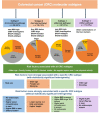Risk Factors and Incidence of Colorectal Cancer According to Major Molecular Subtypes
- PMID: 33442661
- PMCID: PMC7791624
- DOI: 10.1093/jncics/pkaa089
Risk Factors and Incidence of Colorectal Cancer According to Major Molecular Subtypes
Abstract
Background: Colorectal cancer (CRC) is a heterogeneous disease that can develop via 3 major pathways: conventional, serrated, and alternate. We aimed to examine whether the risk factor profiles differ according to pathway-related molecular subtypes.
Methods: We examined the association of 24 risk factors with 4 CRC molecular subtypes based on a combinatorial status of microsatellite instability (MSI), CpG island methylator phenotype (CIMP), and BRAF and KRAS mutations by collecting data from 2 large US cohorts. We used inverse probability weighted duplication-method Cox proportional hazards regression to evaluate differential associations across subtypes.
Results: We documented 1175 CRC patients with molecular subtype data: subtype 1 (n = 498; conventional pathway; non-MSI-high, CIMP-low or negative, BRAF-wild-type, KRAS-wild-type), subtype 2 (n = 138; serrated pathway; any MSI status, CIMP-high, BRAF-mutated, KRAS-wild-type), subtype 3 (n = 367; alternate pathway; non-MSI-high, CIMP-low or negative, BRAF-wild-type, KRAS-mutated), and subtype 4 (n = 172; other marker combinations). Statistically significant heterogeneity in associations with CRC subtypes was found for age, sex, and smoking, with a higher hazard ratio (HR) observed for the subtype 2 (HR per 10 years of age = 2.64, 95% CI = 2.13 to 3.26; HR for female = 2.65, 95% CI = 1.60 to 4.39; HR per 20-pack-year of smoking = 1.29, 95% CI = 1.14 to 1.45) than other CRC subtypes (all P heterogeneity < .005). A stronger association was found for adiposity measures with subtype 1 CRC in men and subtype 3 CRC in women and for several dietary factors with subtype 1 CRC, although these differences did not achieve statistical significance at α level of .005.
Conclusions: Risk factor profiles may differ for CRC arising from different molecular pathways.
© The Author(s) 2020. Published by Oxford University Press.
Figures

References
Publication types
MeSH terms
Substances
Grants and funding
- K24 DK098311/DK/NIDDK NIH HHS/United States
- R01 CA137178/CA/NCI NIH HHS/United States
- R21 CA230873/CA/NCI NIH HHS/United States
- P01 CA087969/CA/NCI NIH HHS/United States
- R03 CA197879/CA/NCI NIH HHS/United States
- R01 CA202704/CA/NCI NIH HHS/United States
- R01 CA151993/CA/NCI NIH HHS/United States
- R35 CA197735/CA/NCI NIH HHS/United States
- K07 CA188126/CA/NCI NIH HHS/United States
- UM1 CA167552/CA/NCI NIH HHS/United States
- UM1 CA186107/CA/NCI NIH HHS/United States
- P01 CA055075/CA/NCI NIH HHS/United States
- P50 CA127003/CA/NCI NIH HHS/United States
- U01 CA167552/CA/NCI NIH HHS/United States
- R00 CA215314/CA/NCI NIH HHS/United States
LinkOut - more resources
Full Text Sources
Medical
Research Materials
Miscellaneous
